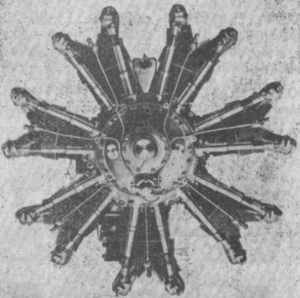Isotta Fraschini Astro 7
The Astro 7 was a 7-cylinder radial engine built by Isotta Fraschini in the 1930s.
| Astro 7 | |
|---|---|
 | |
| Front view of Isotta Fraschini Astro 7 | |
| Type | 7-cylinder engine |
| National origin | Italy |
| Manufacturer | Fabrica Automobili Isotta Fraschini (Isotta Fraschini), Milan |
Design and development
Fabrica Automobili Isotta Fraschini (Isotta Fraschini) was founded in 1898 to manufacture cars and internal combustion engines. Isotta Fraschini engines powered many Italian airships and military aircraft during WWI, becoming one of the largest engine producers in Italy. At the outbreak of WWII Isotta Fraschin had a large portfolio of engines but suffered from a lack of large orders, with a few exceptions. The Astro 7 C seven cylinder radial engine failed to attract orders in any quantity and failed to give the company significant return on the development costs.[1][2]
The Astro 7 C was an unremarkable air-cooled radial engine with supercharger, which did allow reasonable power to be maintained at altitudes up to 4,000 m (13,123 ft), dependent on supercharger drive ratio.[1] With few applications the Astro 7 C family was not produced in large quantities.
Applications
- Caproni Ca.406A (intended)[4]
Specifications (Astro 7C)
Data from Jane's All the World's Aircraft 1938[3], Jane's All the World's Aircraft 1937[1]
General characteristics
- Type: 7-cylinder air-cooled radial piston engine
- Bore: 155 mm (6.10 in)
- Stroke: 160 mm (6.30 in)
- Displacement: 20.8 l (1,269.3 cu in)
- Length: 1,127 mm (44.4 in)
- Diameter: 1,200 mm (47.2 in)
- Dry weight: 328 kg (723.1 lb)
- compressed air starter
Components
- Valvetrain: 2x overhead valves per cylinder driven by pushrods and rockers
- Supercharger:
- Fuel system: Isotta fraschini L.95.I inverted carburetor with automatic height control and centrifugal regulator boost control
- Oil system: pressure system with dry sump and scavenge pump
- 2x Marelli MF.7 magnetos with automatic advance
Performance
- Power output:
- 7 C.20 (take-off) 420 hp (313 kW) at 1,900 rpm for 5 minutes[1]
- 7 C.20 (rated) 500 hp (373 kW) at 2,000 rpm at 2,100 m (6,890 ft)[1]
- 7 C.21 (take-off) 440 hp (328 kW) at 1,900 rpm for 5 minutes
- 7 C.21 (normal) 420 hp (313 kW) at 2,000 rpm at sea level
- 7 C.21 (rated) 460 hp (343 kW) at 2,000 rpm at 2,100 m (6,890 ft)
- 7 C.40 (take-off) 420 hp (313 kW) at 1,900 rpm for 5 minutes
- 7 C.40 (normal) 400 hp (298 kW) at 2,000 rpm at sea level
- 7 C.40 (rated) 440 hp (328 kW) at 2,000 rpm at 4,000 m (13,123 ft)
- Compression ratio: 6:1
References
| Wikimedia Commons has media related to Isotta Fraschini Astro 7. |
- Grey, C.G.; Bridgman, Leonard, eds. (1937). Jane's All the World's Aircraft 1937. London: Sampson Low, Marston & company, ltd. pp. 72d–75d.
- "Isotta Fraschini aero engines". www.pilotfriend.com. Retrieved 6 April 2020.
- Grey, C.G.; Bridgman, Leonard, eds. (1938). Jane's All the World's Aircraft 1938. London: Sampson Low, Marston & company, ltd. p. 73d.
- "Caproni aircraft". Secret Projects Forum. 1998. Retrieved 6 April 2020.